Following the discussion in Part I of alternative history games and novels that depict a world in which the Axis powers won World War II, I intend to investigate the reality of German technology developed in wartime, to see how the two compare. There are plenty of bizarre and far-fetched technologies purportedly contemplated or developed by Nazi Germany during the Second World War, ranging from the deadly 'Die Glocke' to the titanic mechanised robots of MachineGame's 'Wolfenstein: The New Order'. In many alternative history scenarios, the Axis victory has resulted from the development of highly advanced technology by the Nazis, giving them a considerable advantage. What technology would prove to be such a game-changer, and were the Nazis close to developing anything that would give them this advantage?
The Nazis operated with the clear intention to produce advanced technology which would out-perform that of their enemy nations. Third Reich propaganda quite blatantly referred to particular revolutionary 'superweapons' as Wunderwaffe, or a 'wonder-weapon'. Most of the Nazi's outrageous ideas only made it to being prototypes or reached the military sphere too late to have any significant effect. However, additions made to Germany's military might were great over the period of the war, and include many naval vessels, battleships and U-boats; armoured vehicles, including anti-aircraft and anti-tank weaponry; a glider named 'Mammut' or Mammoth, aptly named, as it's the largest glider ever built; many jets and rocket-propelled aircraft; and many missiles.
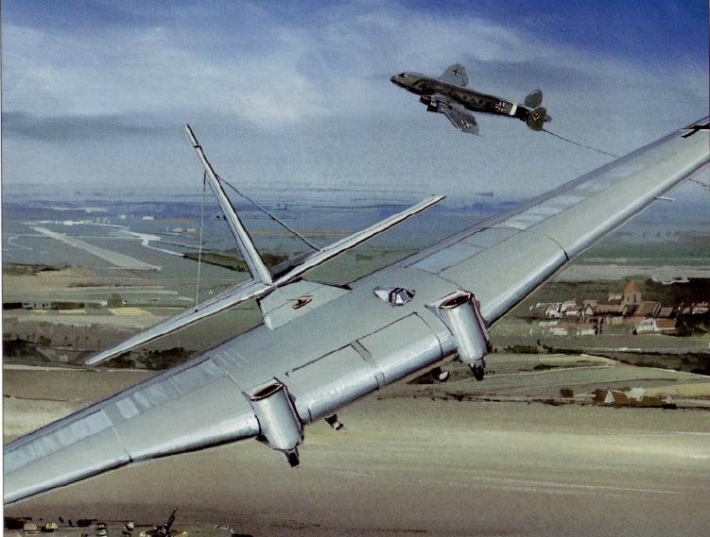
The Junkers Ju 322 Mammut 'Mammoth' military glider.
At the beginning of the 20th century, Germany could boast a great number of successful Physicians and Chemists, many of whom received Nobel Prizes for their work. Many German scientists were prominent in early nuclear research, Otto Hahn, Frizt Strassman, Kurt Diebner and Werner Heisenberg, to name a few. Like the American's Manhattan Project, the Nazis had their own programme for nuclear research. By the end of the war, they had come close to developing a functional atomic weapon in the laboratory, but had not the means to apply production to an industrial scale. It was a German physicist, Heisenberg, who calculated that nuclear fission chain reactions may be possible. The scientists working on the programme succeeded in making small amounts of Uranium 235 by isotope separation. Then using a centrifugal method, they were able to achieve significant enrichment in small samples of uranium by the end of the war in 1945. However, this was nowhere near enough to make a bomb.
Successful production of significant amounts of radioactive material would not be enough to create a fully functioning weapon. A moderator, to slow down neutrons liberated by the chain reactions, would also be needed. Instead of water or graphite, the German scientists chose to use heavy water (oxygen combined with the rare heavy isotope of hydrogen). This was a tactical choice, and an error. They expected to use a Norsk hydro plant in Nazi-occupied Norway to supply heavy water cheaply, but Norwegian resistance and Allied bombing prevented the Nazis from holding this area. These setbacks prevented Hitler from achieving the goal reached by the Manhattan Project.
It was a personal obsession of Hitler's to see New York in flames. He saw the American nation as his ultimate adversary and was focused on building a long range weapon which could make his dream a reality. If the Nazis had succeeded in creating an atomic bomb, it is likely that the American city would have been the first target. It is therefore surprising that the Nazis did not succeed in building an atomic bomb, as they apparently had the scientists, the resources and the motivation. They were unable to expand the programme to an industrial scale because of the commitment of valuable resources in other kinds of military technology. Hitler's dream of destroying New York with a long-range weapon was instead resting upon the success of the V-2 rocket.
The V weapons, short for Vergeltungswaffen, or 'retaliatory weapons' were a set of long-range artillery weapons designed for strategic bombing during the war, considered to be part of the 'Wunderwaffen'. A number of weapons were planned, but only V-1 and V-2 were used in a campaign 1944-5. The V-2 rocket was the world's first operational liquid fuel rocket.
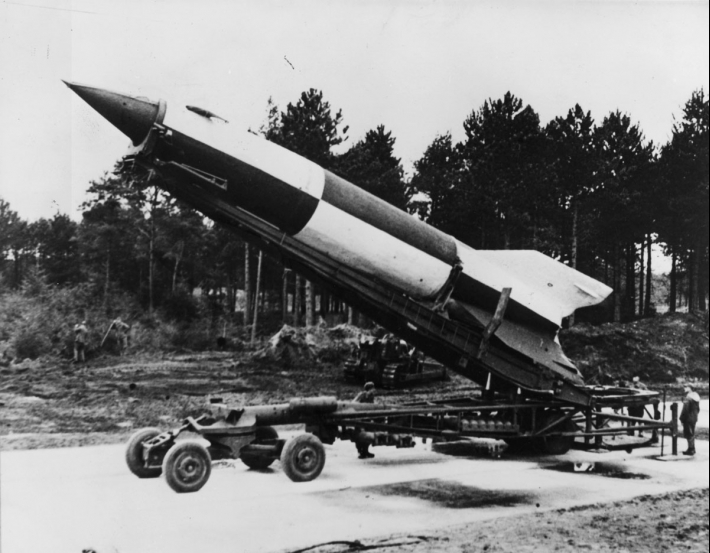
V-2 rocket ready for launch at Cuxhaven in Luneburg district of Lower Saxony.
Credit: Getty Images
The V-1 rockets were horribly destructive, but at least they couldn't boast stealth. The pulse jet engine was noisy and when it reached its target and began to dive, the propulsion unit would cut out, causing a silence that warned of the incoming attack. However, the developed V-2 rocket, launched mainly upon London from sites around The Hague in the Netherlands, was a whole new experience. First launched on the 8th September 1944, the missile took an estimated 5 min to fly 200 miles from The Hague, in the Netherlands, to London. The rockets were supersonic and so the explosions came without warning. Not only were they silent, but they were tremendously destructive. Hundreds were killed in a single rocket strike. It is estimated that 1,115 V-2s were fired at the UK in total, mainly at London, killing thousands. The British government tried to conceal cause by blaming defective gas mains, earning the rockets the name 'flying gas pipes' by the public. Sustained attacks on London continued between October 1944 and March 1945. This is likely to have solidified the image of the Nazis as being capable of deadly and silent attacks using advanced technology.
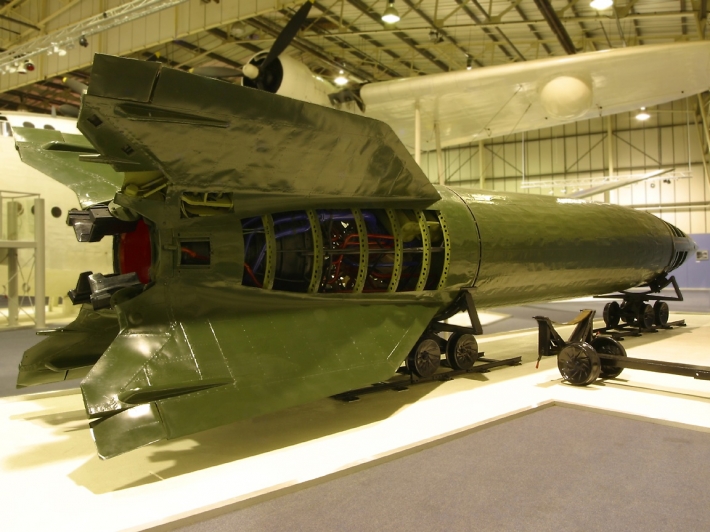
Hendon, V-2 rocket in colour.
Credit: RAF Museum
However, as horrific as the V-2 was as an instrument of war, it was possibly a waste of resources and was not capable of changing the course of the war. The development programme cost at least $2 billion in 1945 dollars ($26,603,912,353 billion dollars today) and 6,034 missiles were built. As a proportion of gross national product, the development and production of the V-2 rocket is ranked with the Manhattan product. Unlike the Nazi's Vergeltungswaffen, the American atomic bomb was vital in changing the outcome of the second world war. Ironically, some have commented that the V-2 rocket's stealthiness removed the psychological impact that would have had a more significant military impact. It seems that Hitler directed Germany's resources towards the wrong project, perhaps the outcome would have been different if the Nazis had chosen to pursue their Nuclear Programme with more ardour.
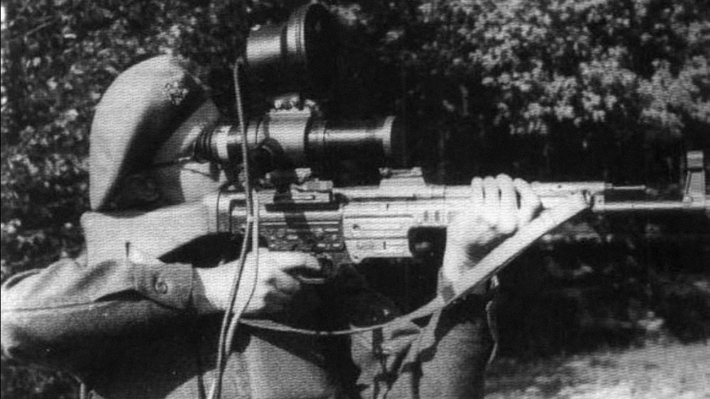
The Zielgerät 1229, an active infrared device developed for the Wehrmacht for the Sturmgewehr 44 assault rifle.
Credit: forum-der-wehrmacht.de
The Zielgerät 1229, otherwise known as 'Vampire Scope', was a piece of technology as much a silent killer as the V-2 rocket. This night vision attachment for the Nazi Sturmgewehr 44 assault rifle turned members of the Wehrmacht into faceless, stealthy killers who attacked under the cover of darkness. Along with the supersonic V2 rocket, this night vision technology helped to form an image of the Nazis as silent and deadly, which could have made them seem more threatening. The code name 'Vampir' supports the idea that this was seen as a development that would grant almost superhuman, supernatural powers. It is little wonder that conspiracy theories have arisen suggesting that the Nazis sourced their technology from the supernatural or occult.
Some Nazi Wunderwaffe were less successful, making it only to prototype. Many of these feature ambitious plans for weapons that were the biggest and most deadly, seemingly taken straight from the most fanciful of Science Fiction novels. One such example is the proposed design for the Landkreuzer D1500 Monster, a vast tank measuring 150 feet that supposedly was capable of firing shells as large as existing tanks.
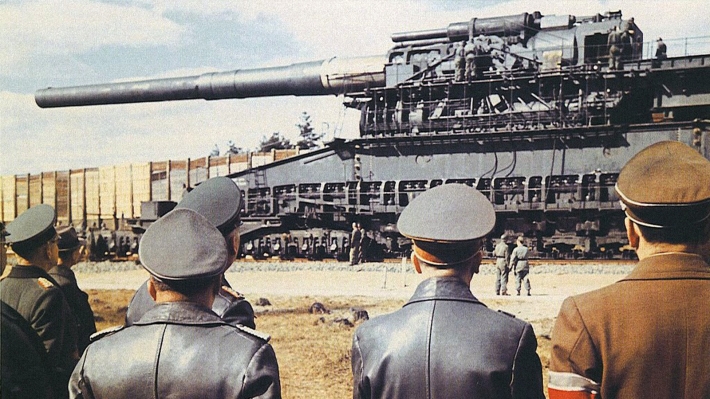
Hilter inspects Schwerer Gustav alongside Heinrich Himmler, Martin Bormann and Albert Speer, 1941.
Credit: The Third Reich Colour Pictures
A similarly staggering weapon proposal was the 'Sun Gun', details for the plans of which were uncovered during post-war Nazi interrogations. Plans developed by Hermann Oberth in 1929 consisted of a 100m wide concave mirror, part of a space station 5,100 miles above Earth. Made of metallic sodium, this mirror would be used to reflect sunlight onto a concentrated point on Earth, the heat of which could burn a city or make an ocean boil. It brings to mind images of a mean child with a magnifying glass. The Nazis believed a device like this could be operational within 50 - 100 years.
The Nazis put a great amount of effort in creating directed-energy weapons, and succeeded in building an electron accelerator called Rheotron to create x-ray synchrotron beams for the Ministry of Aviation (Reichsluftfahrtministerium). This was planned to serve as anti-aircraft weaponry to disrupt ignition in aircraft engines and bring them down within reach of flak artillery. This weapon was a success, but was captured by the Americans in 1945.
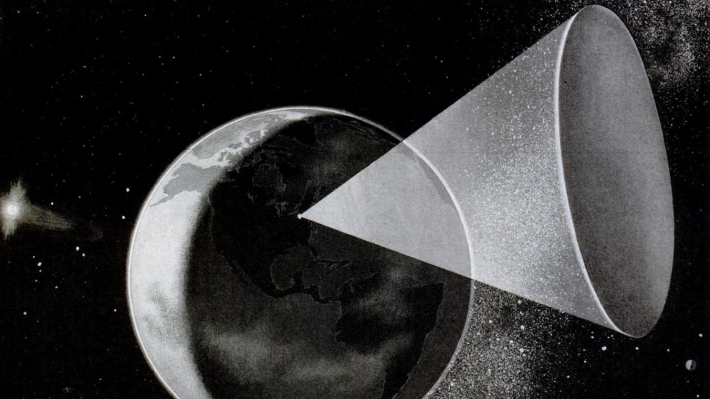
Nazi 'Sun Gun'.
Credit: Life Magazine (July 23th 1945)
There are many strange tales and exaggerations been proposed about the Nazis, especially regarding the origins of their advanced technology. Some have suggested that Hitler was contacted by UFOs and that their technology is extraterrestrial, whereas others have cited occultism as the source. One such myth is Die Glocke, which is worth mentioning to exemplify the kind of terrifying technological developments the Nazis were believed to be capable of. They were known to be conducting extreme and cruel experiments, paying little attention to the well-being of their human subjects (often taken from POW camps), and this image of the Nazis was extended into such conspiracy theories surrounding their research. Die Glocke was a great metal bell, with deadly uses, that originated in the works of Igor Witkowski. He claimed to have discovered this strange piece of weaponry while reading transcripts from an interrogation of former Nazi SS Officer, Jacob Sporrenberg. The tale was retold by British author Nick Cook in 'The Hunt For Zero Point', in which he claims that the US government has been working for years on anti-gravity technology that was confiscated from the Nazis at the end of WWII.
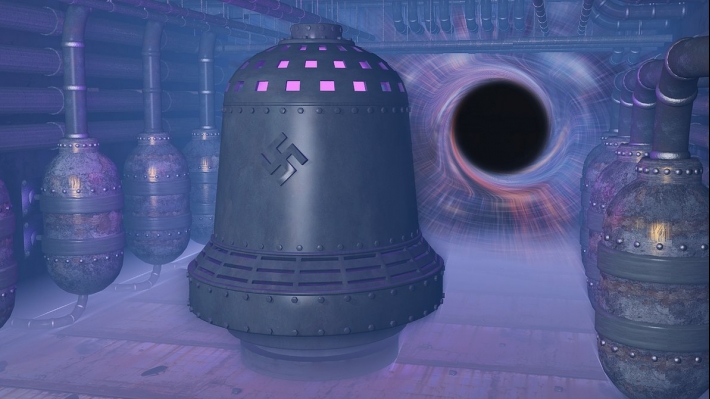
'Die Glocke'.
Credit: Vitaloverdose / DeviantArt
Die Glocke has been described as being shaped like a bell, approximately 9 feet wide and 12-15 feet high, and made of a hard, heavy metal. Inside are two counter-rotating cylinders, filled with a violet, mercury-like substance, code-named Xerum-525. The bell emitted strong radiation, which apparently led to the death of many scientists. This strange idea has taken hold in the popular image of the Nazis and has become associated with Nazi occultism and free-energy research. It seems to encompass so many of the stereotypes of the Nazis that were found most threatening, may which have already been suggested in this article. Die Glocke's method of killing, by radiation poisoning, was stealthy and unstoppable, akin to the V2 rocket and 'Vampire Scope'. They had become an unseen terror, capable of mass killings. The notion of free-energy research goes so strongly against the laws of physics, it exemplifies the general belief that the Nazis had insatiable ambition and believed that not even the laws of the universe could be a barrier to them.
It seems the Nazis were hindered by the very characteristics that are employed to make them terrifying in alternative history novels and games. The idea that they were interested in, and capable of, silent and stealthy murder is supported by the types of technology they successfully designed, the V-2 rocket and the 'Vampire Scope' night-vision attachment. Myths and conspiracies such as Die Glocke epitomise the stereotypes that surround the Nazis. Their over-reaching ambition and disregard of common morality fuel fantasies that the Nazis were receiving their technology from supernatural or extraterrestrial sources. They had a desire to create superior and unique 'Wunderwaffe,' a trait that is exploited in games such as 'Wolfenstein: The New Order', in which the Nazi leaders are often concealing plans for a secret super-weapon of mammoth proportions. However, in putting their efforts into developing 'Wunderwaffe' such as those mentioned in this article, in particular, the deadly V-2 rocket, the Nazis were unable to commit sufficient resources to their nuclear programme. If they had chosen to race America to the creation of an atomic weapon, the course of modern history may have been very different.
References & Further Reading
- Cooke, 'The Hunt For Zero Point', Century Random House (2001).
- 'Wolfenstein - The New Order' (Bethesda Softworks / Machine Games).
- Nobelprize.org : The Official Website Of The Nobel Prize.
Listing image: Bethesda Softworks / Dead End Thrills
